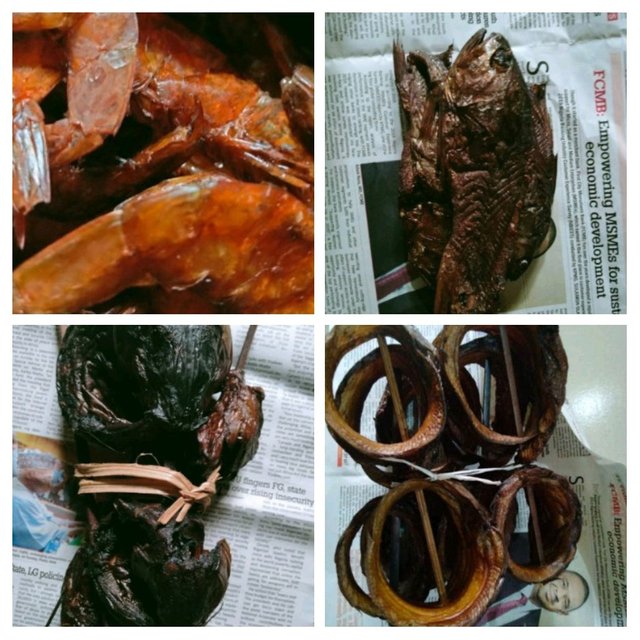
Smoke Preserved Fishes and Crustaceans.
Aquaculture is lucrative in Nigeria and it is a very important department of the overall agricultural sector. Like all successful ventures in life, fish farming has its own pitfalls mitigating against it's successes. Of all problems faced by practitioners of Aquaculture in Nigeria, the most important is the preservation of aquacultural produce, both farm-bred and artisanal.
Before we delve into this discus on the problems of fish preservation in Nigeria, I'll like to first intimate my readers with the two main branches of Aquaculture. The first is Fish Farming, this is where you breed fishes or any edible aquatic species within a controlled man made or natural aquatic environment. The second main branch of Aquaculture is called Artisanal fishery. This is when you don't really rear the fish or edible aquatic species but you harvest them from their natural habitat, often times fresh water bodies like rivers, lakes, natural ponds or brackish water systems or even from our high seas.
Of the two types of aquaculture in Nigeria, fish farming is the most popular and lucrative and it constitutes over 60% of the overall Aquacultural practice in Nigeria. Artisanal fishery practices in Nigeria is done mostly on small scale by local fisher folks. But even at that it brings in a broader species variety of edible aquatic species to Aquaculture than Fish farming which contributes a fewer variety of bred species most notably, the catfish and the tilapia.
Fishes are very perishable food products by nature. A few hours after harvesting them from their aquatic environment, they start a rapid deterioration process that will eventually within 12 hours render them inedible without any intervention to stop the spoilage process. The best way to preserve freshly harvested fishes is often by keeping in an environment with very low temperatures close to the freezing temperature of water. This way fishes can be kept fresh without any loss of value to it's taste.
Preserving freshly harvested aquatic species with low temperatures means there must be a refrigerator nearby or appreciable quantities of good quality ice at hand. But in Nigeria, it's unfortunate that preservation of fish products with low temperatures is not a feasible option. The unstable electric power supply in Nigeria seriously mitigates against fresh preservation of fishes with low temperatures. It's very expensive to run backup electric power generators to compensate for the irregular power supply so other alternatives have been innovated over time and one amongst many have come to become the standard, Fish Smoking.
Fish Smoking is the gold standard fish preservation technique in Nigeria. It is cheap and offers a longer shelf life to Aquacultural produce than most preservation techniques. It's often done with the hot blazing coals of burnt wood. The fishes are placed on a rack suspended above the hot red coals and this is usually done in stages to prevent outright cooking of the fish or worse incinerating them. Smoking fishes with an aim to preserve is done in three stages. The first stage involves removing the easily putrefied internal organs then spreading them on a rack over the hot coals with a spacious cover on top to help prevent loss of heat. They are left this way for two to three hours with careful monitoring of temperature and the heat source. The first stage is done mainly to remove excess water from the fishes by heat.
After the fishes have been considerably dehydrated, they are removed from the rack and stored in a place safe from vermin. The next day the same process is repeated but for a shorter duration until a loss of 70% of the body water content. The last stage, the same process like the first and second but for a still shorter duration is done to reduce body water content to less than 85%. At this stage without supplementation with refrigeration, the smoked fish produce has a shelf life of 21 days. With refrigeration, you can keep your fish free from spoilage for more than 7 months.
In a country like Nigeria with poor electricity problems, the only way to eat fresh fish for the majority of poor people whom cannot afford backup electricity generation is cooking and eating your fresh fish within the first few hour of it's harvest. The predominantly eaten preserved fish types here are the smoked ones.
Fresh fishes taste great, eating fish with very little tampered nature is delicious but smoked fishes are very delectable in traditional African cuisines. The smoking process concentrates the fishes natural flavours and in addition brings to it a wild gamy flavour characteristic of smoked animal protein.
I do hope you enjoyed my article on fish preservation in Nigeria. Thanks for your time reading, bye for now and stay safe.
CC @belenguerra
CC @bright-obias
NOTE
THIS POST WILL BE SHARED ON TWITTER.
This post has been shared on Twitter.

https://t.co/7Lh8fgZ8HH?amp=1
Downvoting a post can decrease pending rewards and make it less visible. Common reasons:
Submit
Very insightful. Fish is a very good protein source.
Downvoting a post can decrease pending rewards and make it less visible. Common reasons:
Submit
Nice articles fish is one of the proteinous aquatic animals. Apart from eating it also used in the fish mill for making fish foods. And there are also more ways to preserve them now
Downvoting a post can decrease pending rewards and make it less visible. Common reasons:
Submit
Thank you for sharing in Steem Geography! Your post has been selected for today as part of the Steemit Communities support Program.
I appreciate a lot your engagement with this community.
I’d love to hear more from you!!
Downvoting a post can decrease pending rewards and make it less visible. Common reasons:
Submit